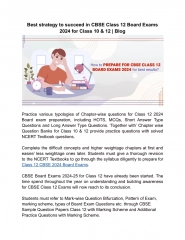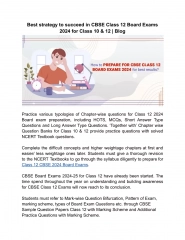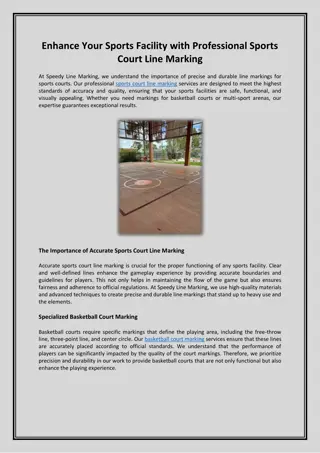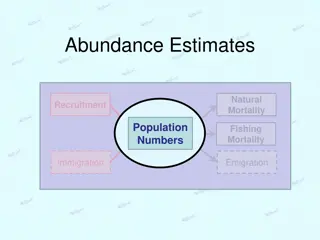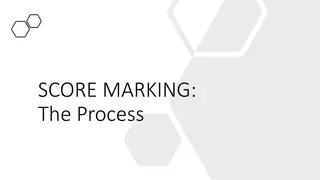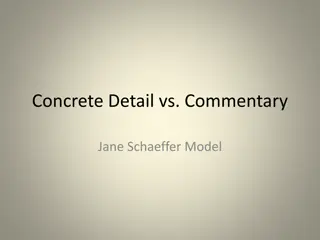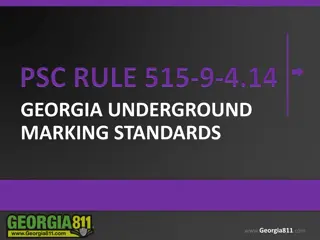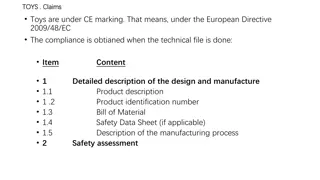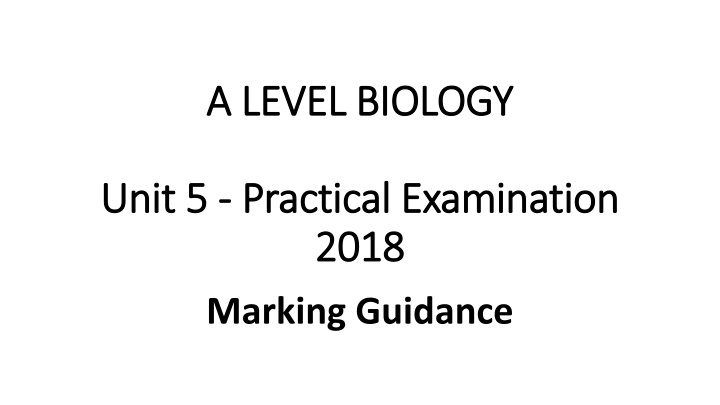
Practical Examination Marking Guidance for A-Level Biology Unit 5
Explore the practical examination marking guidance for A-Level Biology Unit 5, covering proper headings, units, recording times accurately, and calculating means correctly. Make sure to follow the instructions to enhance your performance in the examination.
Download Presentation

Please find below an Image/Link to download the presentation.
The content on the website is provided AS IS for your information and personal use only. It may not be sold, licensed, or shared on other websites without obtaining consent from the author. If you encounter any issues during the download, it is possible that the publisher has removed the file from their server.
You are allowed to download the files provided on this website for personal or commercial use, subject to the condition that they are used lawfully. All files are the property of their respective owners.
The content on the website is provided AS IS for your information and personal use only. It may not be sold, licensed, or shared on other websites without obtaining consent from the author.
E N D
Presentation Transcript
A LEVEL BIOLOGY A LEVEL BIOLOGY Unit 5 Unit 5 - - Practical Examination Practical Examination 2018 2018 Marking Guidance
Headings (1) Units (1) All times (raw data) to nearest second (1) Means calculated correctly - accept to 1 dp if rounded must be checked (1) (a) (a) TABLE TABLE P8 Headings correct Units correct All times to nearest second Means calculated correctly to 1 dp Ignore number formatting
Headings (1) Units (1) All times (raw data) to nearest second (1) Means calculated correctly - accept to 1 dp if rounded must be checked (1) (a) (a) TABLE TABLE P2 Headings incorrect not enough detail + mean not stated Units correct Times recorded to 1 dp Means calculated correctly to 1 dp 2 marks P3 Headings incorrect time taken for Units incorrect - cm3 not vol / secs not s Times recorded to nearest second Means calculated correctly to 1 p 2 marks P12 Headings correct Units moldm-3 not vol Times recorded to 1 dp Means calculated correctly to 1 dp 2 marks
Headings (1) Units (1) All times (raw data) to nearest second (1) Means calculated correctly - accept to 1 dp if rounded must be checked (1) (a) (a) TABLE TABLE P4 Headings incorrect mean not included in overall title Units incorrect v not vol Times recorded to 1 dp Means calculated correctly to 1 dp 1 mark P7 Headings incorrect vol of H2O2 and time taken to rise only not sink and rise Units incorrect - cm3 not vol Times recorded to nearest second Means calculated correctly to 1 dp 2 marks
Headings (1) Units (1) All times (raw data) to nearest second (1) Means calculated correctly - accept to 1 dp if rounded must be checked (1) (a) (a) TABLE TABLE P10 Headings incorrect - Does not state concentration Units incorrect cm3 not vol + minutes not s Times recorded in minutes and seconds Cannot calculate mean of minutes and seconds 0 marks P11 Headings incorrect does not state concentration of what or time for what Units incorrect - sec not s Times recorded to nearest second Variable number of dps in mean 1 mark NOTE: if two completely separate tables are drawn both tables must be correct to award a marking point
P8 (b) (b) GRAPHS GRAPHS Axis labels (1) Use of grid (1) Plots (2) Units (1) Scales (1) Lines (1) Axis labels includes mean on y axis Units correct Use of grid at least 50% each direction Scales are suitable Plots correct Lines drawn through centres of plots and labelled 7 marks
P1 (b) (b) GRAPHS GRAPHS Axis labels (1) Use of grid (1) Plots (2) Units (1) Scales (1) Lines (1) Axis labels incorrect BUT ecf from table Units incorrect BUT ecf from table Use of grid 50% each direction Scales are suitable Plots correct Lines drawn through centres of plots not labelled 6 marks
P2 (b) (b) GRAPHS GRAPHS Axis labels (1) Use of grid (1) Plots (2) Units (1) Scales (1) Lines (1) Axis labels incorrect no ecf from table and no mean on y axis Units incorrect no ecf from table Use of grid over 50% each direction Scales are suitable Plots correct Lines of best fit drawn just about 5 marks
(b) (b) GRAPHS GRAPHS some general points some general points Scales: Don t accept inverted scale on x axis P11 Lines: don t accept if they take lines back to an origin of 0 P12 Scales: Accept number other than 0 at origin Scales: must have numbers at origin Scales: Accept broken axis P8 P4 P9
(c) (c) ( (i i) ) CONCLUSIONS CONCLUSIONS Correct comment on their results {competitive/non- competitive/cannot tell because results are too variable} (1) + a suitable explanation : Can't tell because {with/without competitor} time does not level off (1) If competitive, time taken with copper sulphate decreases as concentration of peroxide increased (1) if non-competitive inhibitor, time taken with copper sulphate would not have decreased at higher concentration of peroxide (1) Ideal non-competitive inhibitor: no CuSO4 has reached fastest time/Vmax time with CuSO4 slower and does not start to reach fastest time/Vmax at highest concentration Ideal competitive inhibitor: no CuSO4 has reached fastest time/Vmax time with CuSO4 slower but starts to approach fastest time/Vmax at highest concentration Can't tell(results too variable) + some indication of what they would have expected to reach a valid conclusion(1) Answers must be consistent with their results/graph.
(c) (c) ( (i i) ) P8 CONCLUSIONS CONCLUSIONS Correct comment on their results {competitive/non- competitive/cannot tell because results are too variable} (1) + a suitable explanation : Correct comment on results don t show that CuSO4 is acting as a non-competitive inhibitor 2 marks Explains that time taken with copper sulphate decreases as concentration of peroxide increased
(c) (c) ( (i i) ) CONCLUSIONS CONCLUSIONS Correct comment on their results {competitive/non- competitive/cannot tell because results are too variable} (1) + a suitable explanation : P12 Correct comment on results show that CuSO4 is acting as a non- competitive inhibitor which is consistent with the results line with flattens at higher concentration of H2O2 rather than keeping on decreasing 1 mark Does not explain that time taken with copper sulphate did not decrease at higher concentration of peroxide
(c) (c) ( (i i) ) CONCLUSIONS CONCLUSIONS Correct comment on their results {competitive/non- competitive/cannot tell because results are too variable} (1) + a suitable explanation : P1 Cannot accept that it is an inhibitor only BUT results show that you cannot determine this from the results 1 mark Does not explain why you cannot conclude from these results
(c) (c) ( (i i) ) CONCLUSIONS CONCLUSIONS Correct comment on their results {competitive/non- competitive/cannot tell because results are too variable} (1) + a suitable explanation : P6 Should state that no conclusion is possible as times overlap 0 marks Insufficient detail about results being too variable
(c) (c) (ii) (ii) INACCURACY INACCURACY 3 inaccuracies + 1 improvement for each (1 mark each) P4 Temperature + Thermostatically controlled water bath Precision of syringes insufficient detail pH + Use of buffer 2 marks
(c) (c) (ii) (ii) INACCURACY INACCURACY 3 inaccuracies + 1 improvement for each (1 mark each) P7 Temperature + Thermostatically controlled water bath pH + Use of buffer Concentration of enzyme + Control time dipped in yeast 3 marks
(c) (c) (ii) (ii) INACCURACY INACCURACY 3 inaccuracies + 1 improvement for each (1 mark each) P10 Using same H2O2 + Repeat using fresh H2O2 Improvement would be a different experiment Told to use a single paper disc so in itself not an inaccuracy 1 mark
(c) (c) (ii) (ii) INACCURACY INACCURACY 3 inaccuracies + 1 improvement for each (1 mark each) P1 Improvement is okay BUT does not explain why this is a source of inaccuracy Repeats are not a source of inaccuracy Does not explain that measuring cylinder may not be precise or what the bars are 0 marks
(c) (c) (iii) (iii) RELIABILITY RELIABILITY Correct comment on their results (1) {only repeated once/only 2 results for each concentration/large variation between repeats} + repeat more times to improve reliability (1) P1 States that results are not reliable (check against table of results) 2 marks Gives reason (range) + repeat (check against table of results) P7 States that there were only two results for each concentration and repeats needed to improve reliability. Does not comment on reliability of own results 1 mark
(c) (c) (iii) (iii) RELIABILITY RELIABILITY Correct comment on their results (1) {only repeated once/only 2 results for each concentration/large variation between repeats} + repeat more times to improve reliability (1) P8 States that some results had a large range but does not state which Gives reason (range) + repeat (check against table of results) 1 mark P2 Not enough detail to explain why the means were reliable and does not understand why you cannot identify an anomalous result out of two data items Enough to award 2nd marking point 1 mark

